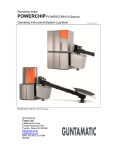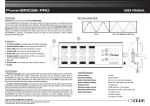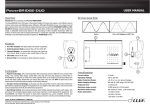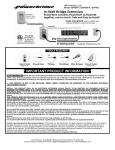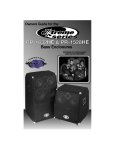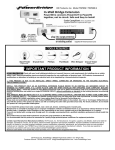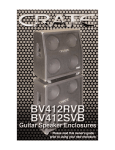Download 009-074-001_rE User Guide, Powerchip.indd
Transcript
USER GUIDE POWERCHIP Welcome Thank you for making Fishman a part of your acoustic experience. We are proud to offer you the finest acoustic amplification products available: high-quality professional-grade tools which empower you to sound your very best. Troubleshooting If you are unfamiliar with this product, please pay close attention to the requirements for installation. Failure to do so can result in permanent damage to the pickup. Installation by a qualified professional is strongly recommended. Technical support, troubleshooting tips and installation information can be found at http://www.fishman.com/support/ Description and Features The Powerchip is a miniature onboard piezo / magnetic pickup mixing preamp, dedicated to the Fishman Powerbridge system. The preamp, mounted to the underside of a piezo volume pot, allows guitarists to combine or split piezo and magnetic pickups without any additional outboard signal routing electronics. 2 Mono Operation Plug a standard mono instrument cable into the output of the Powerchip equipped guitar and combine the magnetic and piezo signals into a single buffered composite, suitable for any available instrument level audio input. Electric Guitar Equipped with Fishman Powerbridge and Powerchip Mono Instrument Cable 3 Electric Guitar Amp Stereo Operation Plug a stereo “Y” cable into the output of the Powerchip equipped guitar and split the magnetic and piezo pickup signals to separate destinations. Send the buffered piezo signal (Ring) to any instrument level audio input, such as an acoustic instrument amplifier or PA system. Send the unbuffered, “immaculate” magnetic pickup signal (Tip) to a traditional electric guitar amplifier, with no added coloration or signal treatment between the magnetic pickup and the amplifier. 4 Electric Guitar Equipped with Fishman Powerbridge and Powerchip Stereo Y-Cable Powerbridge Signal (Ring) Magnetic Signal (Tip) Acoustic Guitar Amp Electric Guitar Amp Piezo Trim and Phase Adjust the small rotary trim pot on the backside of the Powerchip to match piezo and magnetic pickup levels. Move the Phase jumper on the backside of the Powerchip to eliminate phase cancellation between the piezo and magnetic pickups. Piezo Trim Piezo Phase 5 Prepare the Instrument Telecaster style guitars File or sand down the corners of the 9-pin jack to fit the standard Telecaster mounting hole. Stratocaster style guitars You will need to drill out the back wall of the jack cavity to accommodate the supplied 9-pin jack. Remove the output jack from the jack plate, then replace the jack plate on the guitar. Use a pencil through the jackplate to mark the center where your drill will enter the back of the jack cavity. Use a ¾” (19mm) spade bit to drill out the back of the jack cavity. Jack Plate 9 Pin Jack 6 Installation and Connections Warning: The solder pad terminals and the adjacent components on the Powerchip circuit board are quite fragile and can be easily overheated. Use only a low wattage soldering iron (30 watts max) to make your wire connections. To best utilize the space inside the guitar, solder the wires to the circuit board so that they exit toward the volume pot terminals. 1. Strip 3⁄32” (2.4mm) and tin the wire ends of the pickups. 2. Solder the piezo pickup wire to the circuit board. Red Battery The pads are located on the side of the board Wire opposite the volume pot. The piezo hot wire goes to the pad on the right edge of the board, directly under and to the right of the Piezo Hot little white trimmer pot. Solder the piezo Piezo Ground ground wire (which should be left with the Common Output Ground braid intact) to the pad labeled “G” on the Ground (Sleeve) right edge of the board, directly under the piezo hot wire. 7 3. Solder the magnetic pickup hot wire to the circuit board. The pad for the hot wire is located on the same side of the board as the volume pot. This pad, labeled “M,” is on the left edge of the board, ¾” (19mm) from the bottom of the board. A common system ground is located on the opposite side of the board, on a second pad marked “G,” adjacent to the piezo ground. Since there is room for only one wire on this pad, we suggest that you tie all grounds to the body of the magnetic volume pot, and run a jumper wire to the ground pad on the circuit board. Note: If you install the Powerchip with active magnetic pickups (such as EMG), the Powerchip and the active pickups will share the same battery. Connect the positive battery wire from the magnetics to the +9V pad on the Powerchip. Connect the negative battery wire from the magnetics to terminal #1 on the 9-pin jack. Output (Tip) Magnetic In Output (Ring) 3-Position Switch (Optional) 8 4. Solder the 9-pin jack to the system. A prewired output cable from the Powerchip is to be soldered to the provided 9-pin jack. Prepare the jack by soldering a jumper wire between the sleeve terminal, located on the business end of the jack, and terminal #2, directly below. Solder the jack as follows: a. Solder the shield from the output cable to terminal #2. b.Solder the red wire from the output cable to terminal #4. c. Solder the white wire from the output cable the terminal #8. Sleeve d.Solder the black battery wire (negative) to terminal #1. Output Ground (Sleeve) Black Battery Wire Jumper Wire Terminal #2 9 Red Output Wire (Tip) White Output Wire (Ring) Optional Accessories • Battery Compartment—a flush mounted, pivoting compartment allows easy access and quick battery changes. • Piezo/Magnetic Pickup Selector Switch—a three position switch for selecting between piezo and magnetic pickup combinations (see below). Optional Piezo/Magnetic Pickup Selector Switch 10 Specifications Battery Life: Current Draw: Frequency Range: Trim Control Range: Maximum Output Voltage: 200 Hours Less than 2.8mA 20–20,000 Hz 18dB 15V peak to peak 11 WWW.FISHMAN.COM 009-074-001 Rev E 5-10












